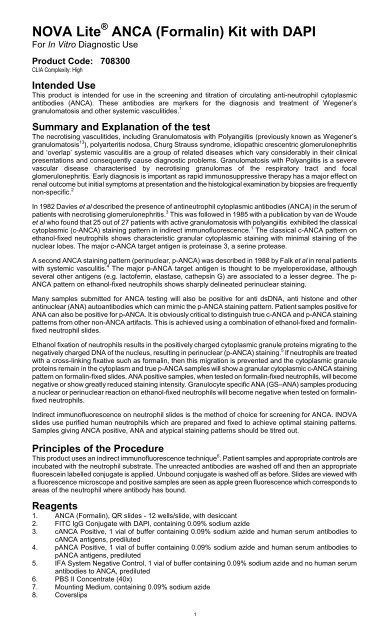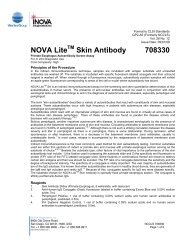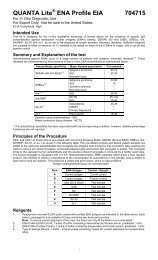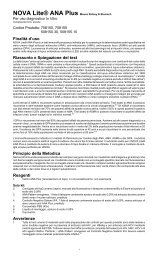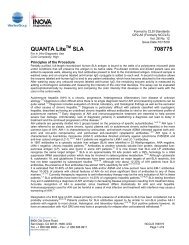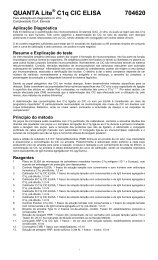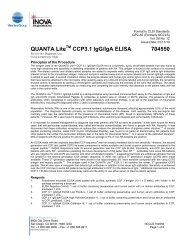NOVA Lite® ANCA IFA Kit - inova
NOVA Lite® ANCA IFA Kit - inova
NOVA Lite® ANCA IFA Kit - inova
- No tags were found...
You also want an ePaper? Increase the reach of your titles
YUMPU automatically turns print PDFs into web optimized ePapers that Google loves.
Warnings1. All human source material used in the preparation of controls for this product has been tested andfound negative for antibody to HIV, HBsAg, and HCV by FDA cleared methods. No test method,however, can offer complete assurance that HIV, HBV, HCV or other infectious agents are absent.Therefore, the p<strong>ANCA</strong> Positive, c<strong>ANCA</strong> Positive and <strong>IFA</strong> System Negative Control should be handled14in the same manner as potentially infectious material.2. Sodium Azide is used as a preservative. Sodium Azide is a poison and may be toxic if ingested orabsorbed through the skin or eyes. Sodium azide may react with lead or copper plumbing to formpotentially explosive metal azides. Flush sinks, if used for reagent disposal, with large volumes ofwater to prevent azide build-up.3. Use appropriate personal protective equipment while working with the reagents provided.4. Spilled reagents should be cleaned up immediately. Observe all federal, state and local environmentalregulations when disposing of wastes.Precautions1. This product is for In Vitro Diagnostic Use.2. Substitution of components other than those provided in this system may lead to inconsistent results.3. Incomplete or inefficient washing of <strong>IFA</strong> wells may cause high background.4. Adaptation of this assay for use with automated sample processors and other liquid handling devices,in whole or in part, may yield differences in test results from those obtained using the manualprocedure. It is the responsibility of each laboratory to validate that their automated procedure yieldstest results within acceptable limits.5. A variety of factors influence the assay performance. These include the starting temperature of thereagents, the strength of the microscope bulb used, the accuracy and reproducibility of the pipettingtechnique, the thoroughness of washing and the length of the incubation times during the assay.Careful attention to consistency is required to obtain accurate and reproducible results.6. Over time, the conjugate may change in color due to exposure to light. However, the color changedoes not affect the assay performance.7. Strict adherence to the protocol is recommended.Storage Conditions1. Store all the kit reagents at 2-8°C. Do not freeze. Reagents are stable until the expiration date givenon the box label when stored and handled as directed.2. Once slides are removed from a foil bag, they should be used immediately.3. Diluted PBS buffer can be stored for up to one month at 2-8°C.4. The kit conjugate should be kept out of sunlight, fluorescent or U.V. light whenever possible.Specimen CollectionThis procedure should be performed with a serum specimen. Addition of azide or other preservatives to thetest samples may adversely affect the results. Microbially contaminated, heat-treated, or specimenscontaining visible particulates should not be used. Grossly hemolyzed or lipemic serum specimens should beavoided. Following collection, the serum should be separated from the clot. CLSI (formerly NCCLS)Document H18-A4 recommends the following storage conditions for samples: 1) Store samples at roomtemperature no longer than 8 hours. 2) If the assay will not be completed within 8 hours, refrigerate thesample at 2-8°C. 3) If the assay will not be completed within 48 hours, or for shipment of the sample, freezeat -20°C or lower. Frozen specimens must be mixed well after thawing and prior to testing. Repeated freezingand thawing should be avoided.ProcedureMaterials Provided70830020 <strong>ANCA</strong> (Formalin), QR slides - 12 wells1 15mL FITC IgG Conjugate with DAPI1 0.5 mL c<strong>ANCA</strong> Positive1 0.5 mL p<strong>ANCA</strong> Positive1 0.5mL <strong>IFA</strong> System Negative Control2 25mL PBS II Concentrate (40x)1 7mL Mounting Medium1 20 Coverslips1 Direction Insert2
Additional Materials Required But Not Provided1. Distilled water2. 1L container (for diluting PBS)3. Micropipettes and disposable tips4. Moist chamber5. Squeeze bottles or Pasteur pipets6. Coplin jar7. Fluorescent microscopeMethodBefore you start1. Bring all reagents and samples to room temperature (20-26 o C) and mix well.2. Dilute PBS Concentrate: IMPORTANT: Dilute the PBS Concentrate 1:40 by adding the contents ofthe PBS Concentrate bottle to 975mL of distilled or deionized water and mix thoroughly. The PBSbuffer is used for diluting patient samples and as a wash buffer. The diluted buffer can be stored forup to 4 weeks at 2-8°C.3. Dilute Patient Samples:a. Initial Screening: Dilute patient samples 1:20 with diluted PBS buffer (i.e., add 50µL of serumto 950µL of PBS buffer).b. Titration: Make serial 2-fold dilutions from the initial screening dilution for all positive sampleswith diluted PBS buffer (i.e. 1:40, 1:80, 1:160, 1:320, etc). For example: Take 100µL of the1:20 dilution, mix with 100µL of PBS to give a 1:40 dilution. Repeat for further dilutions.Assay procedure1. Prepare Substrate Slides: Allow the substrate slide to reach room temperature prior to removal fromits pouch. Label it with pencil and place it in a suitable moist chamber. Add 1 drop (20-25µL) of theundiluted positive and the negative control to wells 1 and 2 respectively. Add 1 drop (20-25µL) ofdiluted patient sample to the remaining wells.2. Slide Incubation: Incubate the slide for 30 ±5 minutes in a moist chamber (a dampened paper towelplaced flat on the bottom of a closed plastic or glass container) will maintain the proper humidityconditions. Do not allow the substrate to dry out during the assay procedure.3. Wash Slides: After incubation, use a plastic squeeze bottle or pipet to gently wash off the serum withdiluted PBS buffer. Orient the slide and stream of PBS buffer so as to minimize wash-over of samplesbetween wells. Avoid directing the stream directly onto the wells to prevent substrate damage.If desired, place the slides in a Coplin jar of diluted PBS buffer for up to 5 minutes.4. Addition of Fluorescent Conjugate: Tap off the excess PBS buffer. Place the slide back in themoist chamber and immediately cover each well with a drop of fluorescent conjugate. Incubate theslides for an additional 30 + 5minutes in the dark.5. Wash Slides: Repeat Step 3.6. Coverslip: Coverslip procedures vary from lab to lab; however, the following procedure isrecommended:a. Place a coverslip on a paper towel.b. Apply mounting medium in a continuous line to the bottom edge of the coverslip.c. Tap off the excess PBS buffer and touch the lower edge of the slide to the edge of thecoverslip. Gently lower the slide onto the coverslip in such a way that the mounting mediumflows to the top edge of the slide without air bubble formation or entrapment.7. View slides under fluorescence microscope: Finished slides should be stored at 2-8°C and viewed assoon as possible.Quality ControlA positive control (c<strong>ANCA</strong> Positive or p<strong>ANCA</strong> Positive) and the <strong>IFA</strong> System Negative Control should be runon every slide to insure that all reagents and procedures perform properly. Additional suitable control seramay be prepared by aliquoting pooled human serum specimens and storing at < -70 o C. In order for the testresults to be considered valid, all of the criteria listed below must be met. If any of these are not met, the testresults should be considered invalid and the assay repeated.1. The undiluted c<strong>ANCA</strong> Positive must be > 3+.2. The undiluted p<strong>ANCA</strong> Positive must be > 3+.3. The <strong>IFA</strong> System Negative Control must be negative.If the controls do not appear as described, the test is invalid and should be repeated.3
Interpretation of ResultsNegative Reactivity. A sample is considered negative if specific nuclear and cytoplasmic staining is equal toor less than the <strong>IFA</strong> System Negative Control. Samples can exhibit various degrees of background stainingdue to heterophile antibodies or low-level autoantibodies to cytoplasmic constituents such as contractileproteins.Positive Reactivity. A sample is considered positive if specific cytoplasmic staining as described below isobserved to be greater than the negative control and the staining intensity is 1+ or greater.Determine the fluorescence grade or intensity using these criteria:4+ Brilliant apple green fluorescence3+ Bright apple green fluorescence2+ Clearly distinguishable positive fluorescence1+ Lowest specific fluorescence that enables the nuclear and/or cytoplasmic staining to be clearlydifferentiated from the background fluorescencePattern Interpretation. A variety of patterns of cytoplasmic staining can be exhibited depending on the typesand relative amounts of autoantibodies present in the sample. The following types of staining patterns may beobserved:c<strong>ANCA</strong> or cytoplasmic staining: Formalin-fixed slides, c-<strong>ANCA</strong> positive samples will show generalizedgranular cytoplasmic fluorescence . This pattern is usually found to be produced by antibodies reacting withthe primary granule enzyme Serine Protease 3 (PR3) or myeloperoxidase (MPO).Nuclear stainingOn formalin-fixed slides, most nuclear antigens have been destroyed, therefore the ANA positive sampleswill show negative or greatly reduced fluorescence in the nucleus.Limitations of the Procedure1. Heat inactivated, hemolyzed, microbially contaminated or incompletely defibrinated samples maycause high background staining and make interpretation difficult. Obtain a fresh sample and retest.Addition of 2% albumin or bovine serum to the PBS buffer used to dilute samples may reduce thebackground staining of problematic samples.2. Positive <strong>IFA</strong> results should be confirmed by myeloperoxidase (MPO) and proteinase 3 (PR3) enzymeimmunoassays (EIA). 11,12 Formalin fixed <strong>ANCA</strong> slides may also contribute to the determination ofautoantibody specificity, especially for moderate and high titre samples.3. <strong>ANCA</strong>-positive samples may not always test positive for myeloperoxidase (MPO) or serine proteinase3 (PR3) using EIA, as other multiple primary granule antigens may be responsible for classical p- or c-<strong>ANCA</strong> positive staining pattern. These include elastase, lactoferrin, cathepsin G, cationic protein 57and other as yet unidentified neutrophil antigens.4. Anti-smooth muscle (actin) antibodies may react with ethanol-fixed human neutrophils as well asalloantibodies such as mart or NB1 7 . Actin or smooth muscle antibodies react with neutrophilcytoplasm giving a homogeneous rather than the typical coarse speckled c-<strong>ANCA</strong> staining pattern.Alloantibodies also react with the neutrophil cytoplasm giving a fine speckled staining pattern.Typically, only 40% of cells or less will fluoresce.5. Samples may contain more than one antibody, e.g. c-<strong>ANCA</strong> and p-<strong>ANCA</strong> or c-<strong>ANCA</strong> and ANA.6. Neutrophil reactive antibodies may also be found in the serum of patients with inflammatory boweldisease or ulcerative colitis 8 . On ethanol-fixed neutrophil slides, these samples appear as a p-<strong>ANCA</strong>pattern with much accentuated perinuclear staining. On formalin–fixed neutrophil slides thesesamples appear negative or give very greatly reduced fluorescence.7. Use of reagents from other types of fluorescent antibody kits (especially conjugate) may adverselyaffect the sensitivity and specificity of the ethanol-fixed neutrophil substrate slides.8. The light source, filters and optics of different fluorescence microscopes will influence the sensitivityof the kit. The performance of the microscope is significantly influenced by correct maintenanceespecially centring of the vapour lamp and changing of the lamp after the recommended period oftime.9. Only pencil should be used to label the slides. Use of any other writing material may cause artifactualstaining.10. All coplin jars used for slide washing should be free from all dye residues. Use of coplin jarscontaining dye residue may cause artifactual staining.11. This test alone should not be consisdered diagnostic. All other factors including the clinical history ofthe patient and other serological or biopsy results must also be taken into account.12. The assay performance characteristics have not been established for matrices other than serum.4
Performance CharacteristicsExpected Values% positivePatient group No. p-<strong>ANCA</strong> c-<strong>ANCA</strong>Healthy persons 30 0 0Crohn’s disease 80 25 0Ulcerative colitis 46 46 0Primary sclerosing cholangitis with inflammatory bowel disease 17 58 0Primary biliary cirrhosis 25 28 0Autoimmune hepatitis 15 33 0Wegener’s granulomatosis 30 0 100Polyarteritis nodosum * 5 0 100All of the above information has been derived form Seibold et al 9 , except that marked *, which was obtainedby in-house studies at The Binding Site Ltd.PrecisionTen patient sera (three p-<strong>ANCA</strong>-positive, three c-<strong>ANCA</strong>-positive, two ANA-positive and two negative) wereassayed nine times (in triplicate on three separate kit lots). The staining pattern for each sample differed byno more than one staining unit (based on a scale of 1+ (weak staining) to 3+ (strong staining)).Comparison study100 clinical serum samples and 40 normal adult donor sera (20 males, 20 females) were tested on BindingSite’s <strong>ANCA</strong> combi kit and a competitor’s slide kit. Results were as follows:CompetitorThe Binding Sitec-<strong>ANCA</strong> p-<strong>ANCA</strong> ANA Neg. p-/c-<strong>ANCA</strong>c-<strong>ANCA</strong> 60 3 0 0 0p-<strong>ANCA</strong> 3 27 0 0 0p-/c-<strong>ANCA</strong> 0 0 0 0 1ANA 0 0 6 0 0Neg. 0 0 0 40 0134 out of 140 samples tested gave identical results by the two methods. For the c-<strong>ANCA</strong> pattern, the relativesensitivity was 95%, the relative specificity was 96%, and the relative agreement was 96%. For the p-<strong>ANCA</strong>pattern, the relative sensitivity was 90%; the relative specificity was 97% and the relative agreement was96%. For the six samples giving different patterns, all demonstrated very strong or very weak staining on oneor both of the kits, which can make interpretation difficult.5
References1. Van der Woude F.J. et al (1985) Autoantibodies against neutrophils and monocytes: Tool fordiagnosis and marker of disease activity in Wegener’s granulomatosis. Lancet I, 425-9.2. Goeken J. A. (1991) Antineutrophil cytoplasmic antibody – a useful serological marker for vasculitis, J.Clin. Immunol. 11, 161-174.3. Davies D. J. et al (1982) Segmental necrotizing glomerulonephritis with antineutrophil antibody:possible arbovirus aetiology? Br. Med. J. 285, 606.4. Falk R. J. and Jenette J. C. (1988) Antineutrophil cytoplasmic auto antibodies with specificity formyeloperoxidase in patients with systemic vasculitis and idiopathic neutotizing and crescenticglomerlonephritis N. Engl. J. Med. 318, 1651-7.5. Charles L. A., Falk R. J. and Jenette J. C. (1989) Reactivity of antineutrophil cytoplasmicautoantibodies with HL-60 cells. Clin. Immunol. Immunpathol. 53, 243-253.6. Weller T. H. and Coons A. H. (1954) Fluorescent antibody studies with agent of Varicella and HerpesZoster propagated in vitro: Proc. Soc. Exp. Biol. Med 86, 789-794.7. Stroncek D. F. et al (1993) Neutrophil alloantibodies react with cytoplasmic antigens: a possible causeof false – positive indirect immunofluorescence assays for antibodies to neutrophil cytoplasmicantigens. Am. J. Kidney Dis. 21, 368-373.8. Hardarson S. et al (1992) Antineutrophil cytoplasmic antibody in inflammatory bowel and hepatobiliarydiseases. Clinical Microbiology and Immunology 99, No. 3.9. Seibold, F. et al (1992) Clinical significance of antibodies against neutrophils in patients withinflammatory bowel disease and primary sclerosing cholangitis. Gut 33, 657-662.10. Protein Refence Unit Handbook of Autoimmunity (3 rd Edition) 2004. Ed A Milford Ward. J Sheldon,GD Wild. Publ. PRU Publications, Sheffield. 14.11. Savige J, Gillis D, Benson E, Davies D, Esnault V, Falk RJ, Hagen EC, Jayne D, Jennette JC,Paspaliaris B, Pollock W, Pusey C, Savage CO, Silvestrini R, van der Woude F, Wieslander J, Wiik A.International Consensus Statement on Testing and Reporting of Antineutrophil CytoplasmicAntibodies (<strong>ANCA</strong>) Am J Clin Pathol. 1999 Apr;111(4):507-13. Review.12. Savige J, Dimech W, Fritzler M, Goeken J, Hagen EC, Jennette JC, McEvoy R, Pusey C, Pollock W,Trevisin M, Wiik A, Wong R; International Group for Consensus Statement on Testing and Reportingof Antineutrophil Cytoplasmic Antibodies (<strong>ANCA</strong>). Addendum to the International ConsensusStatement on testing and reporting of antineutrophil cytoplasmic antibodies. Quality control guidelines,comments, and recommendations for testing in other autoimmune diseases. Am J Clin Pathol. 2003Sep;120(3):312-8. Review.13. Falk R.J., Gross W.L., Guillevin L, Hoffman G.S., Jayne DR, Jennette J.C., Kallenberg C.G., LuqmaniR., Mahr A.D., Matteson E.L., Merkel P.A., Specks U., Watts R.A. (2011) Granulomatosis withpolyangiitis (Wegener's): an alternative name for Wegener's granulomatosis. Arthritis Rheum. 63(4),863-4.14. Biosafety in Microbiological and Biomedical Laboratories. Centers for Disease Control/NationalInstitute of Health, 2007, Fifth EditionManufactured By:I<strong>NOVA</strong> Diagnostics, Inc.9900 Old Grove RoadSan Diego, CA 92131United States of AmericaTechnical Service (U.S. & Canada Only) : 877-829-4745Technical Service (Outside the U.S.) : 1 858-805-7950support@<strong>inova</strong>dx.comAuthorized Representative in the EU:Medical Technology Promedt Consulting GmbHAltenhofstrasse 80D-66386 St. Ingbert, GermanyTel.: +49-6894-581020Fax.: +49-6894-581021www.mt-procons.com628300USA February 2013Revision 1<strong>NOVA</strong> Lite and I<strong>NOVA</strong> Diagnostics, Inc. are registered trademarks. Copyright 2013 All Rights Reserved©6


